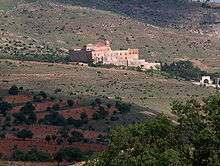Mor Hananyo Monastery
|
| |
 Location within Turkey | |
| Monastery information | |
|---|---|
| Other names | Dayro d-Mor Hananyo |
| Order | Syriac Orthodox Church |
| Established | 493 |
| Dedicated to | Mor Hananyo |
| Controlled churches | Church of the Mother of God, Beth Kadishe |
| People | |
| Founder(s) | Mor Shlemon |
| Site | |
| Location | Near Mardin, Turkey |
Dayro d-Mor Hananyo (Turkish: Daryülzafaran Manastırı, Syriac: ܕܝܪܐ ܕܡܪܝ ܚܢܢܝܐ; The Monastery of St. Ananias, Kurdish: Dêra Zehferanê) is an important Syriac Orthodox monastery. The monastery is located in the Syriac cultural region known as Tur Abdin, and is located three kilometers south east of Mardin, Turkey.
It is usually better known by its nickname, the 'Saffron Monastery' (Syriac: ܕܝܪܐ ܕܟܘܪܟܡܐ, Dairo d-Kurkmo; Arabic: دير الزعفران, Dairu 'l-Za‘farān) which is derived from the warm color of its stone.
History
Dayro d-Mor Hananyo is located on the site of a temple dedicated to the Assyrian sun god Shamash, which was then converted into a citadel by the Romans. After the Romans withdrew from the fortress, Mor Shlemon transformed it into a monastery in 493 AD.[1] In 793 the monastery was renovated after a period of decline by the Bishop of Mardin and Kfartuta, Mor Hananyo, who gave the monastery its current name.
The monastery was later abandoned and re-founded by the bishop of Mardin, John, who carried out important renovations and moved the see of the Syriac Orthodox Church here before his death on the 12th of July 1165.[2] Therefore, From 1160 until 1932 it was the official seat of the patriarch of the Syriac Orthodox Church, after which it was moved to Damascus. However, The Patriarchal throne and many relics are still located in the Monastery, as well as the Tombs of various Patriarchs.[3]
“Three kilometres east of Mardin is the monastery of St. Ananias which, with interruptions, was the residence of the Syriac Orthodox patriarch from 1166 to 1923. It is situated at the foot of a mountain that, like a Swiss Emmental cheese, is full of niches and caves, dug out by hermits who withdrew to live in them. Especially rigorous ascetics had themselves walled into their caves for years, or even their whole lifetime; novices from the nearby monastery would pass them water and a little food through a small hatch. If a hermit left his bowl untouched for 40 days, his death was assumed, and the stone wall was broken down. This was like an early, voluntary choice of one’s own grave, a custom that was also widespread in Buddhist Tibet up to the Chinese invasion of 1950. It was hermits like these that gave Tur Abdin its name. . . . I then visited the subterranean tomb of the monastery and found, in the seven room-size vaults, three Syriac Orthodox patriarchs and four archbishops buried seated on thrones in full regalia.”[4]
The monastery has 365 rooms - one for each day of the year.
- The Saffron Monastery
- The tree lined path to the monastery
- The main entrance, taken from the outer courtyard
- The inner courtyard
- The Patriarchal throne
 Close-up picture of a column inside the monastery
Close-up picture of a column inside the monastery Mor Hananyo Monastery, or The Saffron Monastery in English
Mor Hananyo Monastery, or The Saffron Monastery in English Bible and Pulpit
Bible and Pulpit
See also
References
- ↑ http://cso-france.voila.net/Monastere_Safran.htm
- ↑ http://www.syrianchurch.org/ch/saffronmonastery.htm
- ↑ sor.cua.edu/ChMon/MardinDKurkmo/
- ↑ Traces in the Desert: Journeys of Discovery across Central Asia. (2008). Christoph Baumer. I. B. Tauris, New York, p. 21.
External links
| Wikimedia Commons has media related to Deyrulzaferan. |
Coordinates: 37°17′58″N 40°47′33″E / 37.2994°N 40.7926°E
